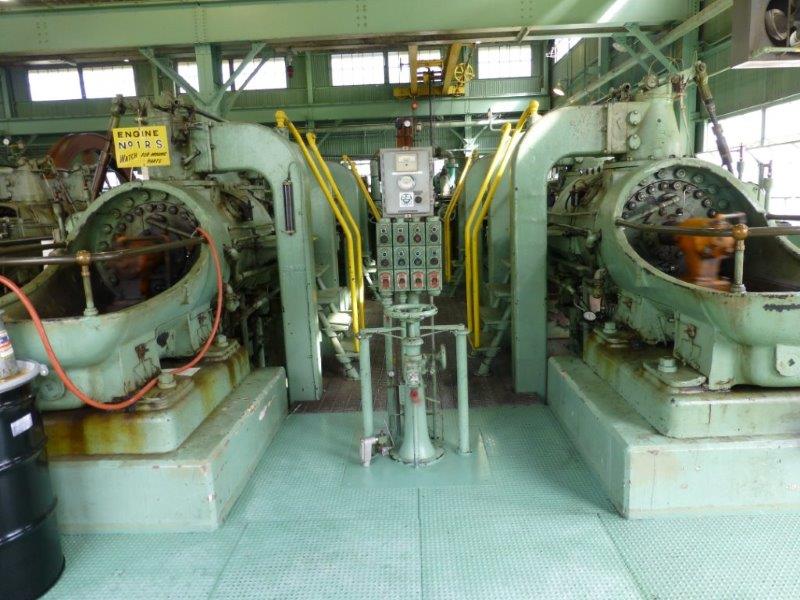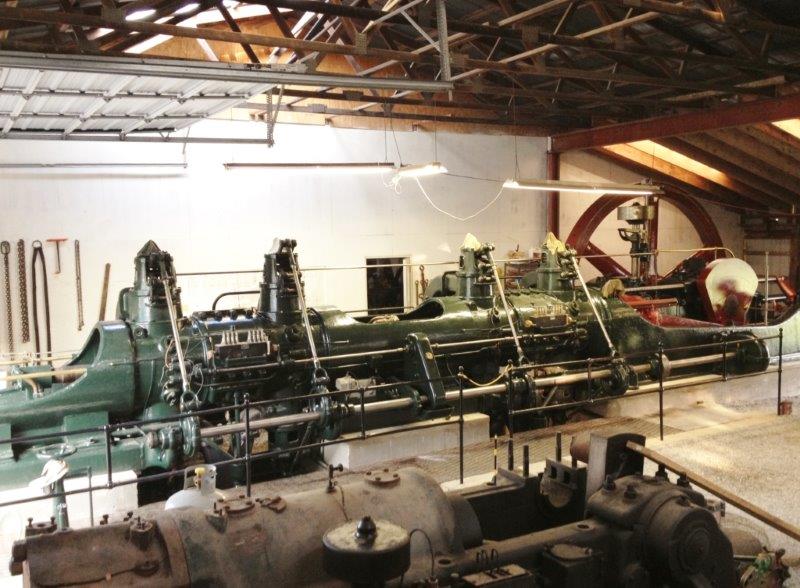
November 2013
The Last of the Giants
By Paul Harvey
Winter is now fast approaching and, after a successful Fall Show, the Museum is now in hibernation until Spring. This is the time to sit back and reflect on all the happenings of the past Summer, both on sights seen and visited as well as accomplishments here. This is a special happening that I wish to share with you although it has a sad ending. It is the story of some magnificent giants and their coming death. Our story unfolds with a phone call that I received from Columbia Gas back in April.
Located in the small village of Rockport, WV, about one
hour south-east of Parkersburg, there was a compressor station with
three 1,000 hp twin, tandem, double-acting Cooper gas compressor engines
still in operation. This was the last station anywhere to my knowledge
that still operated these giants. They were nearing the century mark in
age but still running faithfully. The gas company informed me that they
were planning to scrap these engines but they would still be running in
April and for a short time in September. They would be replaced with
two Caterpillar engines which could be remotely started and monitored,
thereby eliminating all the station employees. I was able to visit both
times and will share the photos taken.
Photo 1 shows Rockport Station as I drove in on a sunny April morning. I was welcomed by the engineer and allowed to stroll about and photograph to my leisure. The small building in the foreground houses the office, tool house, and emergency generator. In the background is the station housing the three big Coopers, all happily running. Their function at this time was to pump into the ground the storage gas needed for the next Winter's usage.
As I walked in the door, I was immediately greeted by engine number one, a cam model that has cams on the side shafts to drive the intake and exhaust valves. It was purring along at 100 rpm with a very effortless rhythm. It has a 21 inch bore and 36 inch stroke with a 15 ft diameter flywheel between the two cylinder banks. This is shown in Photo 2. What a sight to see this with two more running engines down the line! There were two cam models and one eccentric valve drive engine at the end. More on this one later. The engineer dated the cam models at 1917 and the eccentric model at 1914. The reader might consider other dates for these engines but they are close to accurate.
Photo 3 shows a front view on this engine with the control panel and flywheel in the middle. This station was spotlessly clean with all the engines wiped down and shining, as well as the floors and station interior. I really did not want to step off the door mat to put a foot print on the floor! Photo 4 shows the same engine from the rear view. The two compressor cylinders can be seen on either side and the massive flywheel in the center. These compressors each had an 8 inch bore with a 36 inch stroke and topped the storage field at 1850 psi. All that 1,000 hp to run these two compressors.
Photo 5 shows a close up view of the 15 ft. diameter flywheel. It was a thrill to stand so close and watch it turn without the slightest wobble. Still running true after 95 years of turning; I wondered how many times? Each engine "side" carried one main bearing which suspended the crankshaft and flywheel in the middle. The wheel weighs about 16 tons and is two piece. As I watched, I was amazed at how quietly all three engines were running.
A view of the station interior is seen in Photo 6. It is taken from the engine number three side, the eccentric valve drive model, and shows its control pod in the center. Note the large, manually operated bridge crane that spans the station. Standing on a platform, I was able to get Photo 7 showing three large and spinning flywheels. Looking closely at this photo, note a spare connecting rod secured to an upright beam on the station. This is on the extreme right hand portion of the photo. Other spare parts were neatly stacked about the building.
Photo 8 shows the eccentric valve drive engine which is certainly the oldest engine and the original Cooper design. Differing from the cam models, this engine has its side shafts mounted low and on the inside of the cylinders. The cam models have their side shafts mounted center-line and on the outside of the cylinders. Instead of cams, there are eccentrics on the shafts that operate the valves by an interesting, lost motion, "alligator link" mechanism. Note the control pod in the center and the flywheel in the background between the cylinders. The compressors were identical for all three engines. Photo 9 is a detail of the lost motion valve mechanism. It provides a very quiet and smooth motion to the valves which was designed to reduce wear. Note the orange tail rod cross head slider that was going back and forth at 100 times a minute. The eccentric model has wide spaced cylinder banks as compared to the cam model and this is shown by comparing photo 3 to photo 8.
Standing on the platform of the eccentric valve drive engine, I was able to capture Photo 10. It is looking out over the six banks of tandem, double-acting power cylinders on all three engines. All running in harmony. Note that the spare connecting rod can be seen in this photo also.
Surrounding the station were several bright red fire extinguishers as seen in Photo 11. These appeared to be ancient at first glance, but were fully modernized and functional. Their color added a bright spot in the April sun. Then looking inside, I found a big wrench ready for use as seen in Photo 12. It has a 5 1/2 inch opening and a handle attached for lifting it by the chain hoist to the location needed. It is a "slugging wrench" with a short handle well beaten by using a sledge hammer to operate it. This was common practice before all the power impact tools were invented! At its prominent location, I am sure that it had been used often.
Returning in September, I was again welcomed but found a very different scene. The station appeared to be unkempt and the engines were grimy, not all wiped clean as in April. The floors were dirty and I sincerely felt sorry for the giants. They were trying to top off the storage field at 1850 psi. and had reached 1700 psi. See Photo 13 which I have entitled "The Last Smoke" of Rockport Station. Number three, the eccentric valve drive engine, was down with a broken main bearing, not to be repaired. As I walked in number 1 and 2 were limping along and soon number 2 had to be shut down for an overheating problem. The "last smoke" seen in the photo is actually water vapor as number one had an exhaust valve leak and had to be shut down that evening. And so the legacy of the Giants came to an end.
But a Cooper still does live! Located at the Rough and
Tumble Engineers' Historical Assoc. show grounds in

Photo 1: Rockport Station

Photo 2: Engine Number 1

Photo 3: Front view of Engine Number 1

Photo 4: Rear view of Engine Number 1

Photo 5: A closeup of the 15 foot diameter flywheel

Photo 6: A view of the station interior

Photo 7: Three flywheels in motion

Photo 8: The eccentric valve drive engine

Photo 9: Detail of the lost motion valve mechanism

Photo 10: A view of the three engines

Photo 11: Station fire extinguishers

Photo 12: A 5 1/2 inch slugging wrench

Photo 13: The "Last Smoke" of Rockport Station

Photo 14: 500 hp Cooper at Rough & Tumble